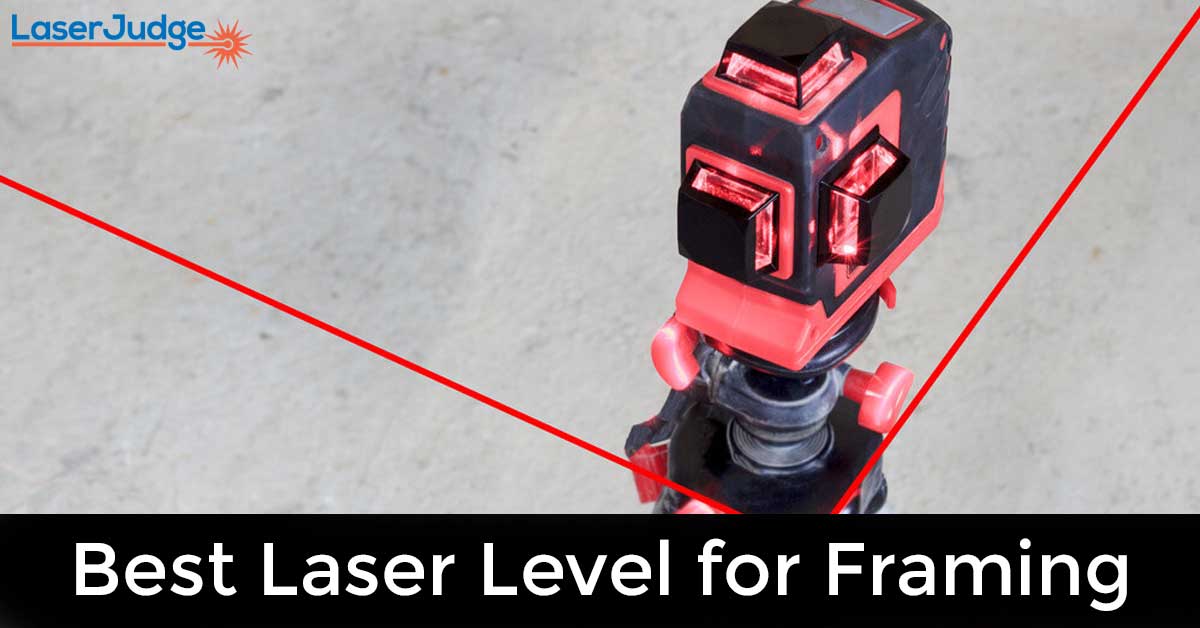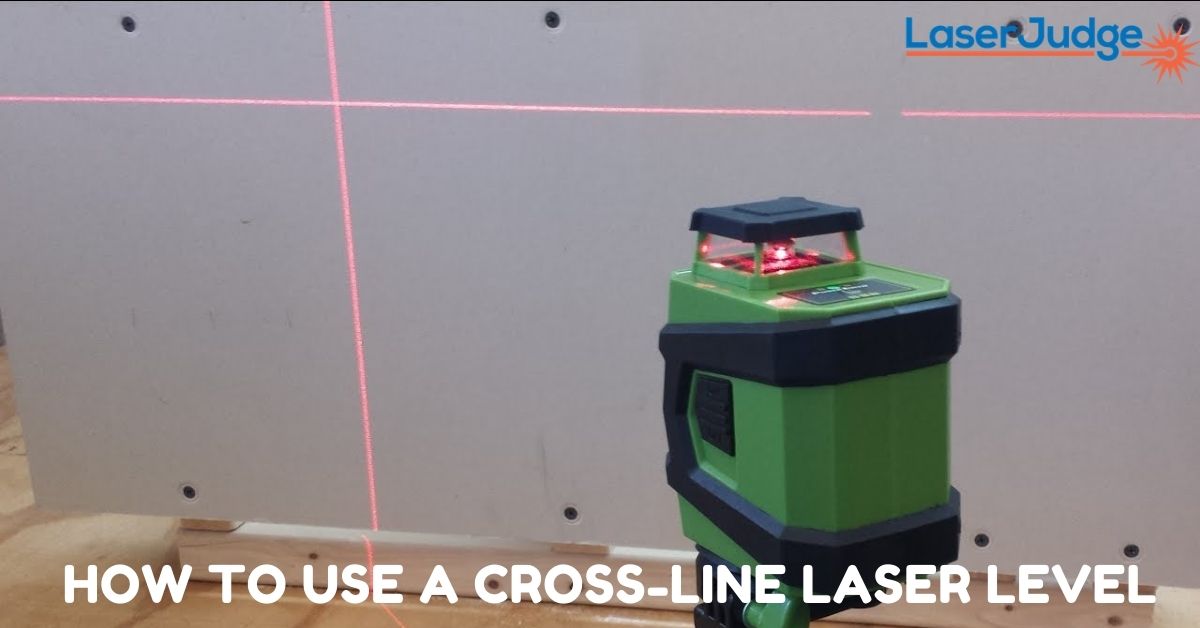A bubble or spirit level is one of the first-level resources that many familiarize themselves with for home projects. To decide whether anything is level or plumb, Spirit levels use a tiny bubble in a circle.
These levels are useful for small data, but a self-leveling laser level will make all the difference to the utmost in precision, quality, and ease. The most substantial laser standards, the next generation of grading technologies, are easy to use. Are you looking for the best laser level for homeowners?
They can do everything that a degree of spirit or bubble can do and even more. How are they functioning? In tasks as varied as adding electrical outlets, hanging photos, and constructing a deck, laser levels project a light beam across a room or construction site to provide a reference point.
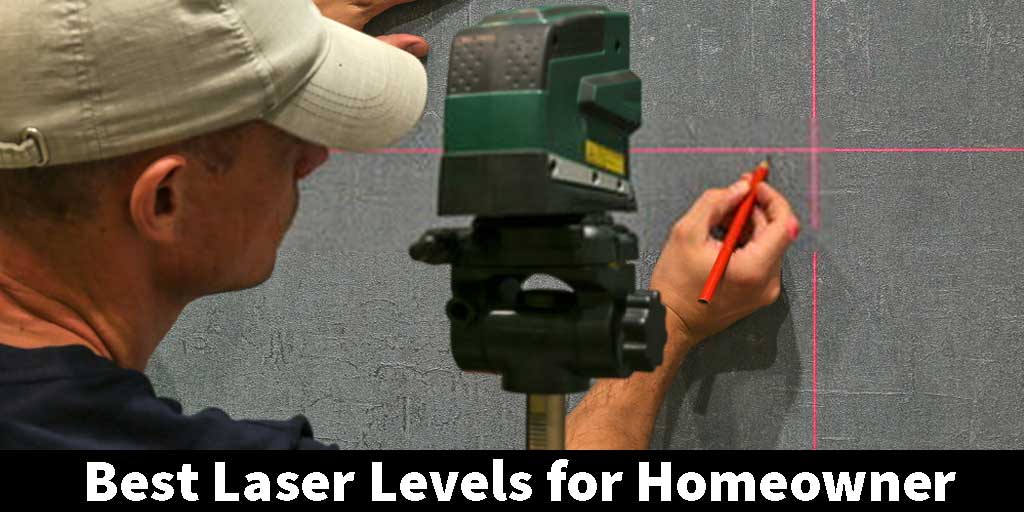
Table of Contents
- Laser Level Types:
- Best Laser Levels for Homeowner in 2022 Reviews & Comparison Table:
- 1. SKIL Self-Leveling Red Cross Line Laser:
- 2. TACKLIFE SC-L03 HOMEOWNER LASER LEVEL:
- 3. SKIL LL932201 360-DEGREE CROSS LINE LASER:
- 4. Tacklife SC-L01 Laser Level:
- 5. Johnson Level 40-0921 Self-Leveling Laser Level Kit:
- 6. BOSCH GLL 30 LASER LEVEL:
- 7. Huepar 9011G DIY CROSS LINE LASER LEVEL:
- 8. Bosch Laser Level and Square GTL2:
- 9. Tavool Self Leveling Cross Line Laser Level:
- 10. Craftsman 2-beam Self-Leveling Laser Level:
- What to consider with the Best Laser Level:
- Laser Level Benefits:
- FAQs:
- 1. How Will A Line-Level Be Used?
- 2. How Will A Laser Level Be Used?
- 3. How to Use A Level of Transit for Grading?
- 4. Which Beam Is Better Red or Green?
- 5. Are All Rotary Laser Levels Water-Resistant?
- 6. Should I Probably Get A Tripod Stand When Using A Rotary Laser Level?
- 7. How Does A Green Laser Vary from A Red Laser?
- 8. What Is the Difference Between the Visibility Range and The Laser Level Operating Range?
- Conclusion:
Laser Level Types:
Much as several occupations involve a laser level, you can select from many distinct categories of levels. They include:
1. Laser Line:
This is the simplest laser level type. When mounted on the wall or surface of choosing, you send out a single level line. This makes it simple and convenient to hang photographs or other objects, as the line offers a level that is easy to read.
2. Dot Laser:
Dot lasers send out a sequence of dots in a level space, as the name would indicate. You will then use these dots to hang whatever you want to hold, even as a reference point.
3. Rotary Laser:
Rotary lasers, in that they project out a line, are similar to line lasers. However, the main difference is that these levels would bring a line on the wall inside any given space. This laser makes it more comfortable for us to ensure that everything is absolutely level on-wall in a room. These are often far more costly and are mostly used for general construction work, such as base concrete work, grading, etc.
Best Laser Levels for Homeowner in 2022 Reviews & Comparison Table:
RANK | Model | Weight | Warranty | Our Rating | Price |
|---|---|---|---|---|---|
1 | 9 ounces | 5 Year | 4.3 | ||
2 | 4.09 pounds | 0 Year | 4.5 | ||
3 | 15.5 ounces | 5 Year | 4.7 | ||
4 | 1.05 pounds | 0 Year | 4.4 | ||
5 | 5 pounds | 3 Year | 4.5 | ||
6 | 8 ounces | 2 Year | 4.4 | ||
7 | 1.15 pounds | 1 Year | 4.3 | ||
8 | 1 pounds | 3 Year | 4.4 | ||
9 | 11 ounces | 2 Year | 4.7 | ||
10 | 2.44 pounds | 0 Year | 4.6 |
1. SKIL Self-Leveling Red Cross Line Laser: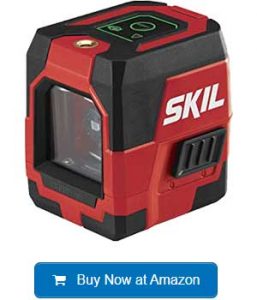
The SKIL Cross Line Laser removes any guesswork in leveling tasks in household leveling practices and enables effortless and uncomplicated operations. On that note, it is the perfect DIY method for busy homeowners who will benefit from its variety of functions and intuitive controls. But, if you’re looking for a high-performance alternative on a tight budget, give this item a shot.
This SKIL model, to begin with, emits bright red horizontal and vertical lines up to 50 feet apart. Often, the system automatically levels, independent of application, while the indications indicate when the lines are not correctly aligned.
This product is also fueled by an integrated lithium-ion battery with a versatile USB charging port for on-the-go recharging. Thus, if you find a decrease in the fee, you can easily plug it in before the next project after looking at the light indicator.
Other than that, we like the provided multi-functional clamp connected to the top or bottom of the panel for comfortable placement on a bench, ladder, etc. Finally, the Locking mode, which helps you place the projected lines at any angle, is the best feature of this user-friendly application.
Finally, it is a superb, budget-friendly model that streamlines tasks such as aligning picture frames, racks, cabinets, and more without infringing on quality.
Features:
- Levels to strip out the guesswork immediately.
- Requires a mini USB charging port
- Driven markers in red, yellow, and green to display the charge
2. TACKLIFE SC-L03 HOMEOWNER LASER LEVEL: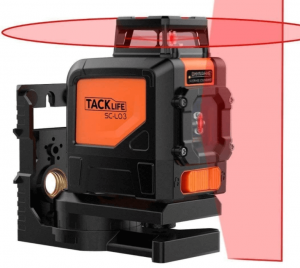
Another mid-range laser stage, the Tacklife SC-L03, is a decent choice if you want a solid unit with a horizontal line of 360 degrees plus a vertical line. Up to 98 feet, it stays visible, and it has a host of features that make it a good money value.
This unit’s intelligent pendulum mechanism will lock in seconds, self-level, and it will blink to show it’s out of the leveling range. Operating with one button makes it fast and straightforward to switch from horizontal to vertical lines; you push one button to switch to manual mode, which is the best laser level for the homeowner.
The Tacklife SC-L03 laser level will help someone who regularly spreads out detailed wall information or DIYers. The pulse mode makes the laser easy to see outdoors, even under very bright light conditions, and this adds to this lightweight configuration with flexibility. In addition, the magnetic pivoting base will conveniently be mounted flush to the wall to speed up the project and ensure that you finish quickly and keep in good spirits in the process.
Features:
- The bright 360-degree level line offers maximum space leveling capabilities that are exact.
- It has a length of 98 feet, ideal for wide and narrow spaces.
- Pendulum locks and indicates high precision when your lines are not level.
- You will switch to different modes by pressing the button for two seconds.
- Pulse mode allows you to project the laser further while retaining illumination.
3. SKIL LL932201 360-DEGREE CROSS LINE LASER: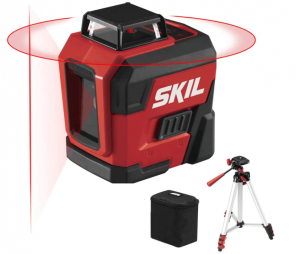
If you want a lightweight and efficient 360-degree cross-line laser that is an outstanding value for your money, the SKIL LL932201 is a reliable option. It will project plumb lines to help you get precise lines, and it has many other fantastic features without breaking the bank.
This can project the laser line up to 65 centimeters. It includes an internal Lithium-Ion rechargeable battery that will last for all-day sessions. When you need something to be straight or hang trim, the self-leveling feature eliminates any guesswork you might have.
You would love to add the SKIL LL932201 to your set and keep it on hand if you are someone who finds themselves rearranging their home a lot on a set budget. The included Tripod goes almost three feet long, and without increasing your annoyance rate or making you go back and redo it later, it makes it easier to finish small and big projects. In addition, you can get straight lines at any angle through the locking mode.
Features:
- Without flickering, lasers can project up to 65 miles.
- The self-leveling functionality eliminates the project’s guesswork.
- It is easy to charge the integrated rechargeable Lithium-Ion battery between uses.
- The Tripod makes it convenient to adjust the laser frequency to be used.
- You can design lines to work in corners or up staircases at any angle.
4. Tacklife SC-L01 Laser Level: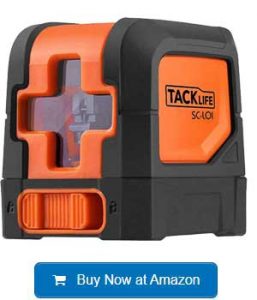
The Laser Line Tacklife SC-L01 is a well-made unit designed for heavy-duty domestic applications. It would inspire us with its solid architecture and various features that automate projects with high precision and implementation. Therefore, we recommend that you try something more robust than the average laser-line ones.
Firstly, we like the self-leveling feature on this unit when put in a vertical or horizontal range of 4°. This is not an impressive spec in itself, but combined with a 50 ft and 115 ft working range and a detector, it’s a spectacular feature.
It also helps consumers know when they position the unit outside of the range as the beam begins to blink before it returns to the range. Likewise, as it returns in reach, a red cross on the target is highlighted for clarification.
Also, we like the rugged design of the model that increases the unit’s life, as it makes it stainless, water-resistant, and shock-resistant. You can then comfortably use it at home for several remodeling projects without too much consideration for injury.
Also, we like the model with a solid magnetic L frame, which can be connected easily to the most readily available tripods on the market.
Features:
- The intelligent pendulum leveling mechanism
- You can adjust the laser 360 ° on a tripod
5. Johnson Level 40-0921 Self-Leveling Laser Level Kit: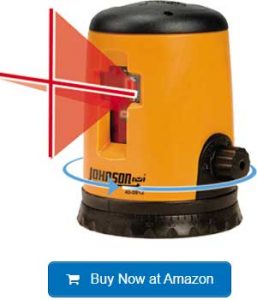
The Johnson Level self-leveling kit is ranked first on our list and is an excellent solution for home use and DIY projects. This sophisticated unit can simultaneously project horizontal and vertical laser beams and support you at various levels throughout the building. Therefore, you can rely on this item for the best results if you look for a leveling system for indoor and outdoor use.
This device is an entry-level kit that is otherwise full of characteristics that simplifies home leveling. First of all, the interior length is 100 feet, suitable for homeowners who need a secure unit when renovating their houses.
Also, the 360 ° graduated base makes it possible to work on any project with angle configurations. The unit immediately leaves within 6 °, so you can only make small changes to achieve an exact amount.
We like the user-friendly and straightforward one switch control and the easily visible red laser beam inside. Besides, we appreciate that the package contains a tripod and a hard-shell case that allows safe storage and transport. Moreover, the locking device, in this case, includes all internal laser level components.
Overall, this is a helpful device that you can use when installing kitchen closets, hanging windows, and other forms of interior leveling or alignment work.
Features:
- Tripod works between 17 and 47 inches
- Projects simultaneously vertical and horizontal lasers
6. BOSCH GLL 30 LASER LEVEL: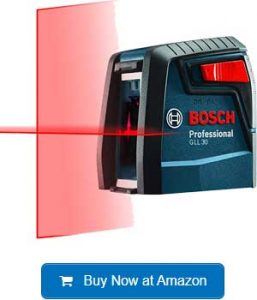
The Bosch GLL 30 is a perfect way to change your space if you have a little renovation work, like hanging photographs or hanging a new clock. It projects two very luminous laser lines, observable up to 30 feet, and the lines are shorter to guarantee better precision.
The functional pocket configuration makes it convenient to bring this laser into your toolkit or pocket from project to project. In addition, it has a lesser power production that makes the batteries run longer and is ideal to level jobs during the day.
People who want to do small jobs alone around the house should add the Bosch GLL 30 to their set and keep it with you. The intelligent pendulum device enables the laser to self-level when identifying locations that are beyond the range. It also has a lightweight, versatile tripod that screws you into the level to provide you with a functional stand anywhere you choose to operate.
Features:
- Crossline projection produces a luminous route to follow.
- The smart pendulum device allows the laser to flow rapidly and effortlessly.
- Tiny measurements will enable the packaging and transfer of this laser.
- Has a high precision rating of up to 30 feet from the laser discharge site.
- It uses a lightweight mount that gives you excellent mobility independence.
7. Huepar 9011G DIY CROSS LINE LASER LEVEL: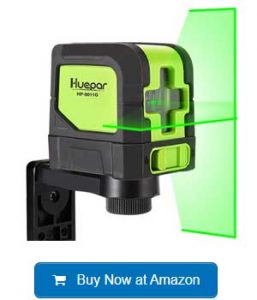
The Huepar 9011 G is a bright laser level for a budget-conscious user. It uses Germany’s latest technologies to ensure that a laser is bright and lightweight, allowing project-by-project transport.
The precision rate is 1/9 inches at 33 feet, and it takes three seconds for your project to proceed from beginning to end. The soft, molded rubber external layer gives this laser toughness and allows it to survive by mistake.
If you’re a homeowner who likes stable but inexpensive equipment, consider purchasing the Huepar 9011G. There is a manual mode to lock the line into a 90-degree angle for small spaces. It has a one-button process that makes it very easy to use, and it’s easy enough to get into your pocket and keep your project on track.
Features:
- Has very lightweight, portable, and easy to carry palm style.
- Green laser light is more intense for improved illumination than typical red laser light.
- Has an automated period of fewer than three seconds to keep the project on schedule?
- This laser level is very user-friendly with a turn.
- The manual operation sets ideal angles of 90 degrees.
8. Bosch Laser Level and Square GTL2: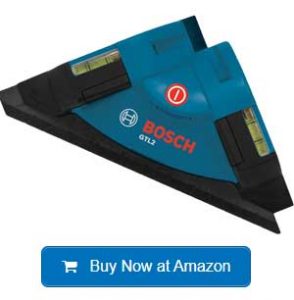
Bosch has recently created multiple waves with its GTL2 Laser Square, and we are delighted with its smooth operability and virtual chalk line projection. It is also another moderately priced choice on our list that is particularly useful for home projects with extremely detailed 90 ° layouts.
Not all of us like a multi-button interface and complex tasks—any of us like a portable laser level unit with simple features. And Bosch implements this specifically with its GTL2 model.
This equipment initially promises up to 1/2-inch precision and a range of 30 ft. The specifications may not seem remarkable, but we are surprised, to be honest, considering the commodity’s price. Furthermore, it helps you to measure and adjust angles for 90 ° configurations in 5 ° increments.
You can then use this leveling and orientation laser tool on the wall or floor to reach the desired angle with a button press. We like the adhesive mounting strips, which allow the instrument to be secured on smooth surfaces without leaving any marks or residues.
Altogether, it is a highly robust system that can lead you through many homes while still providing light on the bag.
Features:
- Projects lateral and vertical lines of crack
- Simple to use one button
9. Tavool Self Leveling Cross Line Laser Level: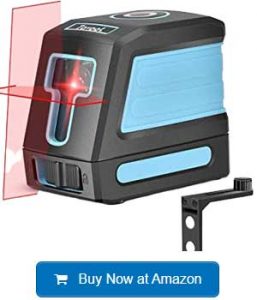
This item would be one of our favorites, considering its place on our chart for its applicability and high performance in any situation. Therefore, if you are looking for an automated low-maintenance system for home refurbishment projects, consider this option, which offers three distinct modes and an operating range of 50 ft.
The unit initially projects extremely visible laser beams, which are visible even in broad daylight. It is also ready to be used from the box after placing the batteries in, and no assembly is needed.
In comparison, it is deadly precise regarding its self-leveling features and lets you know even though you’re marginally out. This method will instantly level up a long story when placed on an inclined surface within 4 °, saving you time and creativity all the time.
It can be quickly shifted from one to the other when working on home repair projects, even with its three-mode service, including vertical, horizontal, and angle laser beams. Furthermore, the activation of a button makes it easy to run because you can switch to the mode and feature you want without a set of controls.
Although what we enjoy most is the battery life that enables you to operate for 15 to 20 hours on a single project, if possible.
Features:
- Mega compact unit
- Laser pulses to display the conditions out of level
- Simple to use and computer
- Three in one with high accuracy and visibility
10. Craftsman 2-beam Self-Leveling Laser Level: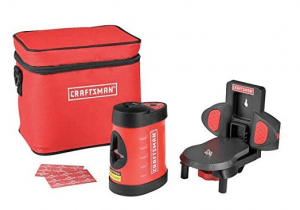
This Craftsman instrument is characterized mostly by its superior range of predictions relative to other laser units at the same price point. Therefore, if you look specifically for an entirely usable device with a wide operational range, we prefer this model because it offers high accuracy and other consistent features.
First of all, this device can cast a red beam up to 100 ft and ensure that the accuracy is ±1⁄4 inches per 30 ft. We like the simplicity of the model in terms of visibility and efficiency regardless of distance.
Moreover, it will automatically warn you if you shift or push the unit out of its stage. Before automated self-leveling, long history emits a noisy sound that alerts users of the problem.
Also, we like this model’s ribbed housing with rubber overfiring, which is a highly durable tool for DIYers. You may then use this item for many indoor applications as it offers an extended battery life of 20 hours, alongside its durable design.
Besides, this extremely flexible device is much cooler as it comes with a precise leveling frame, a laser enhancing glass, and a carry bag.
Features:
- Packed with an integrated alerting sound mechanism
- 100 m. more laser scanning.
- Exceeds a + /-1/4 inaccuracy rate at 30 ft.
What to consider with the Best Laser Level:
Accuracy:
Whether it’s a spirit level or a high-tech laser model, accuracy is a hallmark of any decent level. It will specify a degree of precision on the box or the manual for the best laser settings. However, for a rule of thumb, you can aim for a formula for completely dialed-in performance for less than 1⁄4-inch deviation at 100 feet. However, nearly any self-leveling laser can offer a more detailed line than can be done with a level of spirit.
Self-Leveling:
In the market, the better laser speeds allow a push-and-play technique leveling. To provide stabilization, most models of self-leveling technologies use a laser on a pendulum in a combination of magnets. The pendulum takes over and reaches the final level until it is set on a sufficiently flat floor. This makes it quick and straightforward to set up, especially if you already have a reference point on which you need to register the line.
Laser Receivers/ Detectors:
If you wish to use a rotary laser outdoors, these attachments are a must. These tripod-mounted detectors let you know when your laser is level, as it may be hard to see any colored laser outside, particularly on very bright days. Then, with your dream, you will move ahead, sure that it will be level in the end.
Orientation of Beams:
The beam orientation choice is one of the most significant features at any laser level. Depending on the budget, you can find versions with up to three orientations, vertical, horizontal, and 360-degree. Although the value of the horizontal and vertical beams is evident, a 360-degree laser’s practicality should not be overstated. For example, you can conveniently hang photographs of a whole room’s size or accurately level a part of a yard with a laser range of 360 degrees. These standards are also paramount for the finished product’s quality and intensity with tasks such as drop ceilings.
Green vs Red:
You may not know that, but the laser’s color will make a huge difference. Red lasers are less efficient, but they use much less battery life. On the other hand, green lasers are more visible from a considerable distance and easier to use under sunshine for outdoor projects. However, they are much more effective and more easily dangerous to a consumer’s eyes than a red laser. Nevertheless, many people own green and red lasers for these purposes and use them for tasks that play to their strengths.
Ingress Protection Rating:
Two distinct variables will negatively influence how well the laser level functions are listed in this rating system. The first digit determines how securely the unit is sealed against dust and is on a scale of 1-7—the greater the quantity, the larger the resistance. In the rating scale, the second digit determines how water resistant the standard would be. This is scored on a scale of 1 to 9, with one being the least moisture tolerant and nine fully watertight. You would need to confirm that you have a standard that will give you the protection you need based on these levels, depending on where you will be using that level.
The capability of Remote Control:
Having laser levels with remote control capabilities could prove to be a godsend if one person can perform the task alone. First, however, you would want to remember that in their size, remote controls differ. For example, the most satisfactory remote controls have a range of no more than half of the working distance of the instrument.
Source of Power:
All the levels we looked at were running on some form of battery capacity. This varies from any type of rechargeable and AA batteries. Standard batteries are useful because they are relatively inexpensive and easy to turn off. However, on the other hand, they won’t last as long as a rechargeable battery because they can be used only once.
Battery Life:
The battery life at the stage you select would be heavily dependent on two variables. The first, of course, is the battery type. Rechargeable batteries can last a little longer than regular AA and AAA, as we mentioned above, and can be recharged. On the other side, it takes a while for rechargeable batteries to charge because if they wear out while operating, as ordinary batteries do, they cannot be easily switched out for new ones. How much you use it can be the second element that impacts your battery’s life at your stage. If you’re regularly going to use that level every day, then having a rechargeable battery makes more sense, as you can charge it on a schedule and save some money for yourself. On the other hand, if you only use your amount every once in a while, it would make more sense for regular batteries.
Laser Level Benefits:
A laser level is often used to determine its level for construction workers who project their green or red beam onto a flat surface. While small laser levels can be used for house DIY projects, their more massive counterparts benefit outdoor and building sites.
In comparison, having a laser level will allow you to verify whether the roof and ceiling are flat while building a home. Likewise, if you’re shifting around items, you should ensure that a laser level is put on a flat surface.
Moreover, here are some additional laser level applications for indoors and outdoors:
- Align doors, walls, railings for chairs and shelves
- Installing wainscoting, falling ceilings, and rails for chairs
- Check the ramp, ceiling, and roof heights.
- The setting of a rating for correct irrigation and drainage
- Perform some sort of simple survey
For example, a laser level is useful when hanging floating shelves on a wall or deciding whether an object is plumb and level. However, depending on the maker, most will often self-level, usually located inside four degrees of height.
You can also permit manual mode if needed, allowing you to project non-level or plumb lines. For fully hands-free operation, you can also use mounting clamps that quickly connect to several surfaces.
FAQs:
1. How Will A Line-Level Be Used?
Dig out your patio or other paver walking space. You must ensure that the land under the pavers is low or slightly graduated, making drainage easier. Insert wooden stakes on either side of the hole through. Tie the wooden stakes on either end of a nylon cord, allowing loosely balanced afterward. You placed a line level in the center of the series. Hold the string close to one pin. Go to the other stake and move the string to or from the bubble on the bottle between black lines.
Take a tape measure or stick and calculate the ideal depth according to the appropriate distance from string to field. Take measurements from string to ground at different points along the string, ensuring the center is accurate. Dig, fill, or churn the earth to the correct depth if necessary. Echo the procedure in the other direction over the hole. To further ensure that the floor is straight, use a long box or I-beam straight around the floor.
2. How Will A Laser Level Be Used?
Laser speeds use a laser, an intensified, condensed light stream produced by a solid-state system called a diode. There was a mistake. Laser levels project a light beam used as a visual lime when a straight and consistent reference point is needed.
For example, when you begin building a kitchen cabinet or tiling a wall, you need to know if the floor is flat and how high and low the difference is. You can quickly find out with a laser distance.
Just put the laser on a few wood pieces, or paint can work in a region where a beam is reflected onto the surface. Sketch the floor plan quickly. Then find a spot and apply the measurement to the floor. Note where the beam crosses the tape and mark it on your drawing.
3. How to Use A Level of Transit for Grading?
Adjust the typo place and legs with the knobs attached until the transit is high. Offer your partner the grading rod and place it at the end of the region where you fire the grade. Tell them to position the rod on the ground perpendicular to the ground.
4. Which Beam Is Better Red or Green?
It depends on the order. However, both beams are reliable and can be improved by using laser lenses.
5. Are All Rotary Laser Levels Water-Resistant?
No, just a few versions have complete waterproofing (rainfall and snow). The only Topcon and Spectra Precision models provide full weatherproofing.
6. Should I Probably Get A Tripod Stand When Using A Rotary Laser Level?
Yeah, it’s advisable. A tripod stand will make it easy for you to plumb and check.
7. How Does A Green Laser Vary from A Red Laser?
There are two critical distinctions between the laser levels green and red. First of all, the green laser is 300% lighter than the red laser. This makes it possible to see at a great distance. The second distinction from the first applies to energy consumption. Since green laser levels are more potent, they absorb more power and have a longer battery timescale than red laser levels.
8. What Is the Difference Between the Visibility Range and The Laser Level Operating Range?
The feature separates the presentation from the office. If a laser has 100 feet of working distance – but a visibility length of 500 feet – the latter is of little use to you. So, never search the vision range while checking the specs of a laser standard. Check the working selection instead.
Conclusion:
Laser stadiums shop time, trial, and cash. They are ideally suited for jobs that need precision and accuracy.
If you are a serious maker, laser games are a perfect long-term purchase since you will use them many times and on many different projects.
And if you don’t make a living, laser levels use a tone. You can now check the tables in chairs by pushing a button or building your side desk for the weekend.
Finally, I want my laser critics to help you pick the acceptable laser standard.
Read More:

